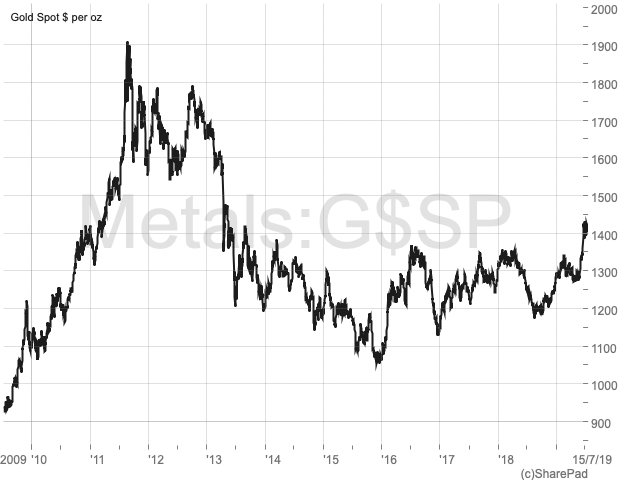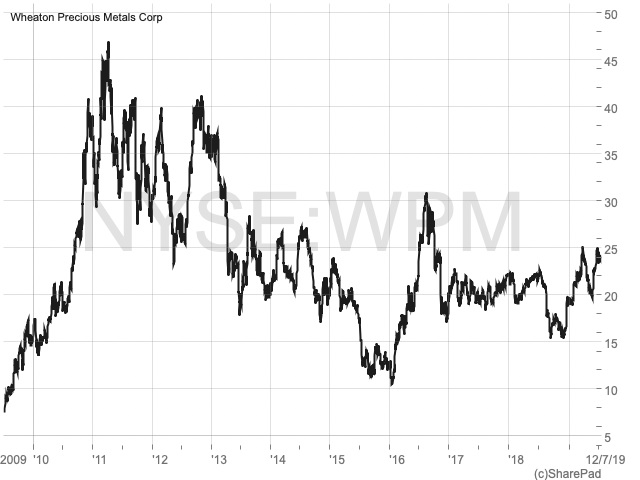Which gold miners should you buy now?

Veteran mining analyst John Cornford unveils his thoughts on where to look for the best bargains in the gold mining sector now that the gold price has perked up.
Now that gold has successfully broken above $1,400, which has prompted some of the more hysterical pundits to suggest it might then fly into the stratosphere, there has been the usual flurry of tips and suggestions to buy gold shares.

The obvious reason to do so is that their mining profits have to be highly geared to the gold price. Compared with a $1,400 per ounce selling price, some miners report their costs to produce as around $700/oz, and others around $1,000/oz. So, a 10% increase to $1,540/oz would deliver a 20% jump in gross profit per ounce for the first one, but a 35% increase for the second. From the $1,200 gold price one year ago, the second will have seen its gross profit double.
But while investors who believe gold is going higher might pile into the second, there are some caveats that are perhaps not all that obvious. While most goldies are boosted initially by a gold surge regardless, the professionals will be more discriminating.
| Master Investor Magazine
Never miss an issue of Master Investor Magazine – sign-up now for free! |
How dependent on gold is that miner, for example? The larger ones often extract a variety of commodities, any other of which might be moving in the opposite direction to gold. This is especially pertinent if the reason (the only reason?) gold might be flying is that economies are in trouble. So who will then want copper, which is often found prolifically alongside gold?
What other hidden snags are there? Ariana (LON:AAU) is a popular junior favourite. But you’d have to look hard in its reports to know that it’s actually a silver miner – accounting for some 90% of ounces produced against 10% gold. It’s only because gold is currently about 100 times more valuable that Ariana reports its silver as ‘gold equivalent’ which it ‘credits’ to gold produced, so apparently reducing the latter’s cost.
If silver moves along with gold that would be fair. But, actually, it hasn’t followed gold up for some time – it was 1.3% of the gold price a year ago, against 1% now, and the ratio of gold to silver currently is almost 50% more than it was five years ago. So you can understand why it isn’t fair! (Although the effect in this case will be small unless that ratio goes even higher.)
Often, other things are going on in a company which a punter shouldn’t ignore. Hummingbird (LON:HUM), for instance, might be thought an obvious beneficiary, with its shares bumping along the bottom. But its Yanfolila mine is being depleted, and there are question marks over how much capital is needed to progress the expansion it needs in a few years’ time to keep going.
The same is true of Anglo Asian Mining (LON:AAZ), one of the sector’s recent stars having multiplied six-fold over the last two years as its mines have started coming into full production. Punters are betting it will continue on up, especially as it’s a low-cost producer and has scope to expand into neighbouring gold-rich areas. But, behind the scenes (or not noticed by the average private investor) is the fact that its valuation now (depending on the future gold price) takes full account of its planned production over the next few years until more capital (or more of the cash it generates which is currently being paid out as dividends) will need to be deployed in new exploration and development to keep the momentum going.
That being said, given time to delve more deeply, AAZ is a share we’ll be keeping an eye on and might discuss in more detail another time.
Just as we don’t have time in this article to go into each goldie in the required detail, neither will we be looking at the majors such as Barrick (NYSE:GOLD), the world’s largest gold miner who a few years ago was counted as one of the lowest cost producers at around $630/ounce.
Neither am I looking at producers in dodgy jurisdictions, like Shanta Gold (LON:SHG) in Tanzania or Caledonia Mining (LON:CMCL) in Zimbabwe. Pan African Resources (LON:PAF) in South Africa is different and hopefully will also be the subject of a later article later.
However, I can provide some pointers as to where I think the gold bull investor should be looking. Given that it is all about the gearing effect, I look for companies more ‘purely’ exposed to gold and without those other complications.
Fitting the bill are the gold ‘streaming’ companies (and the similar ‘royalty buyers’ – a royalty is a fixed percentage of the sales from a mining operation, whereas a stream is a fixed percentage of the physical product) who we wrote about in detail in January 2016. There are none such listed in the UK exposed to gold (Anglo Pacific (LON:APF) deals in iron ore and coal), the main players being in the US and Canada, but because all are large (the top four have a combined $29bn market cap) UK investors should have no difficulty buying the shares.
Although silver might not be mirroring gold exactly, it nevertheless features in my picks. The attraction of Franco Nevada (TSE:FNV), Wheaton Precious Metals (NYSE:WPM), Royal Gold (NASDAQ:RGLD), and Sandstorm (TSE:SSL) is that they avoid the production shocks the average miner is always exposed to, because their ‘stream’ is always the first call on their clients’ output. On top, the deals they strike (whereby in exchange for an upfront payment a producer transfers a sometimes large part of his output to the streamer, at a price sometimes only 1/3rd the prevailing market price, which the streamer then sells on at full price) happen because miners both big and small have been strapped for the cash they need to invest over a long period when funding by other means has been hard to come by.
| Master Investor Magazine
Never miss an issue of Master Investor Magazine – sign-up now for free! |
In fact, so successful are the streamers that they have come to almost supplant traditional sources of mining finance, by re-channelling the funds that investors used to provide directly but which they now prefer to invest via the much less risky streamers.
And it is that trend that has enabled the streamers to become generally much more profitable than the miners themselves, and to see their share ratings much higher. As we calculated for one such typical deal a few years ago, a streamer can extract the equivalent of at least double the effective interest rate on project loans that their client would otherwise have to pay, on top of which it benefits from any increase in the commodity price beyond what it bargained for in the deal.
So, given that the streamers are over the pond, and therefore not so much promoted over here, let’s see what happened the last time gold put on a spurt, from $1,062 in December 2015, to $1,361 in June 2016 – ie a 28% gain.
In that same period the streaming companies put on the following approximate gains: Wheaton Precious Metals +149% from its low; Sandstorm also +140%; Royal Gold +120%; and Franco Nevada (silver only) +81%.
While those gains were to their 2016 peaks (gold fell back to $1,170 in January 2017 before recovering again) all are now higher than when we first wrote about them, because not only do they benefit from the gearing effect of a higher gold price, but they are also expanding their portfolios and streaming deals as funding for the miners by other means has continued to be so difficult. Streamers in other words ‘prey’ on their victims’ – an ideal investment one might say!
As to which one, this article is meant to be general, not pinpointing, because I haven’t performed my usual in-depth analysis. On top of that, I’m not convinced that gold is ready yet for that big jump out of the $1,400 range, and might indeed fall back, in which case some of those recent strong performers will give up their gains. But I’m no gold expert.
However, I do have a medium-term choice based on other analysts’ work, which is Wheaton Precious Metals. Admittedly it’s not a pure goldie, changing its name from Silver Wheaton only a few years ago when its gold streams began to outstrip the silver it started with in 2004. Now, in terms of ounces, silver accounts for about 60 times the volume of WPM’s gold. But in terms of value, silver comprises only about 10% of revenues, with gold accounting for 88% (and Palladium 2%).
It’s not just the high gearing that will attract those who believe in a jump in the gold price, but WPM’s pipeline which is forecast to deliver a 9% expansion in the equivalent gold ounces produced next year. This means that WPM is the one of the four for which North American analysts are forecasting the best share price performance over the next year (neglecting any effect from the unpredictable gold price).
So, what about the gold price? Remember that it’s quoted in US dollars, so if the dollar rises, you’d expect the dollar price of gold to fall (all other things being equal), given that most gold is produced outside America. For what it’s worth, gold specialist Kitco currently reports that gold analysts don’t expect any further rise just yet.
So, it looks as though it’s a bit late this time to catch that gold bump in the streamers. But their time might come again.


I declare a shareholding.
Not a traditional gold producer but looking to produce 50,000oz per annum as a “by-product” of an antimony roaster in Oman, which is about to come on stream is Tri-star Resources (TSTR.LN). Tri-star owns 40% of the project.